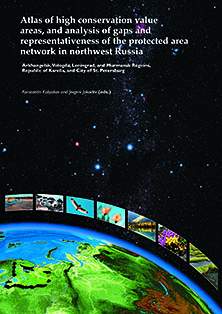
Northwest Russia still boasts huge, almost intact forest and mire landscapes that have, when it comes to their size and biodiversity, no match in Europe. Many of these areas have no protection status. Thus, these areas are decreasing and becoming scattered due to logging and other human activities. The English Edition, Atlas of high conservation value areas, and analysis of gaps and representativeness of the protected area network in northwest Russia, published in September 2013, presents the results of the Finnish-Russian project “Gap analysis in Northwest Russia”.
During the years 2007-2011 a wide range of experts assessed representativeness of the protected area network in northwest Russia by identifying high conservation value areas such as old-growth forests and mire massifs as well as rare and endangered species. The Finnish-Russian Gap project provides recommendations for each region of the study area on development of the protected area network, and lists of natural objects that are in urgent need of protection. The recommendations have already been partly utilized in the regional and federal nature conservation planning.
The results were published in Russian in printed and electronic formats already in 2011. The English Edition was published to secure the availability of these results for the international use.
Implementation
The Gap project was implemented in six regions of the Northwestern Federal District of the Russian Federation: Republic of Karelia, Murmansk Region, Leningrad Region, City of St. Petersburg, Vologda Region and Arkhangelsk Region, excluding Nenets Autonomous District and arctic islands. The aim of the project was to support the international targets of the Convention on Biological Diversity to halt the loss of biodiversity by studying ecological gaps and representativeness of the protected area network in this territory.
The project was coordinated by the Finnish Environment Institute within the framework of the Development Program on Sustainable Forest Management and Conservation of Biodiversity in Northwest Russia, and funded by the Neighbouring Co-operation Funding of the Ministry for Foreign Affairs and the Ministry of the Environment of Finland. The non-profit organization Transparent World was responsible for the technical cartography. Regional coordinators organized working groups involving representatives from regional administrations, scientific institutes and NGOs. The project was implemented with methods developed by the Gap working group, also involving Finnish nature conservation experts.
During the project, a number of seminars, work meetings, training events and field trips were conducted, and they were attended by representatives from government authorities, research institutes and public organizations.
Results
The publication presents the identified, internationally significant high conservation value (HCV) areas in northwest Russia that are particularly important habitats for the region’s native species, sustainable use of ecosystems and nature’s ecological balance.
The publication gives recommendations for further development of the protected area network in the study area. The borders of the HCV areas in the atlas section are sufficiently detailed to support the establishment of new protected areas.
The results of the Gap analysis offer important tools for sustainable land-use planning in local, regional and federal scale. Furthermore, the results are useful for ecologists, conservationists, students of environmental sciences as well as the wider public. The Gap analysis project has played an important educational role, which will undoubtedly manifest itself in the future.
Material and methods
Analyses were based on satellite image interpretation together with topographic maps, archived data and results of field studies. A consistent approach in terms of method and criteria was applied across the region. The identified HCV areas were compared with the protected area network to analyze protection gaps. Regional and federal protected areas as well as planned protected areas were included in the analysis. The analysis was focused chiefly on assessing large areas, and, therefore, some smaller HCV areas were covered by the analysis only partly.
Many known records of red-listed plants, fungi and animals were not included in the maps, as their exact coordinates were not available. The English Edition outlines the current situation and adapts the Russian terminology and definitions to international usage.
The English Edition, Atlas of high conservation value areas, and analysis of gaps and representativeness of the protected area network in northwest Russia (pdf)
GAP analysis 1/12
GAP analysis 2/12
GAP analysis 3/12
GAP analysis 4/12
GAP analysis 5/12
GAP analysis 6/12
GAP analysis 7/12
GAP analysis 8/12
GAP analysis 9/12
GAP analysis 10/12
GAP analysis 11/12
GAP analysis 12/12
More information
Project leader Anna Kuhmonen, Finnish Environment Institute, firstname.surname@syke.fi, tel. +358 295 251 322